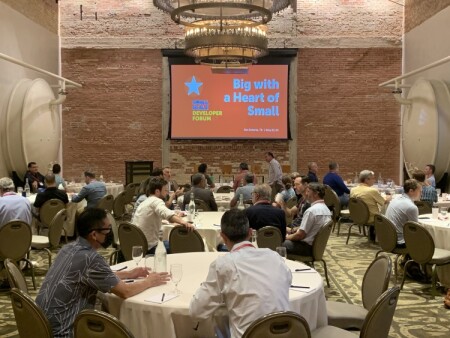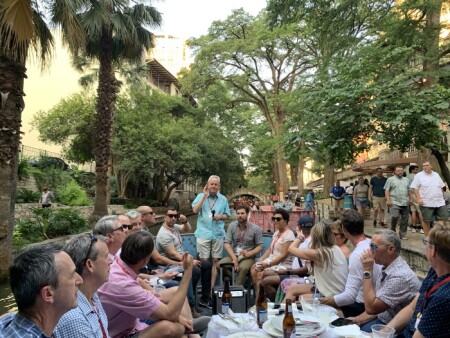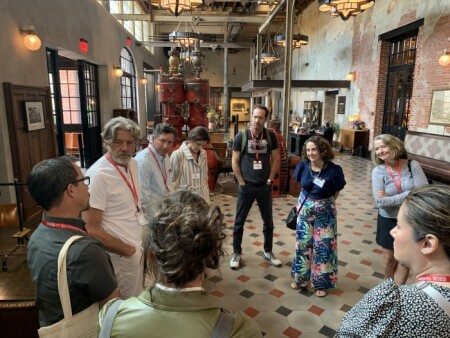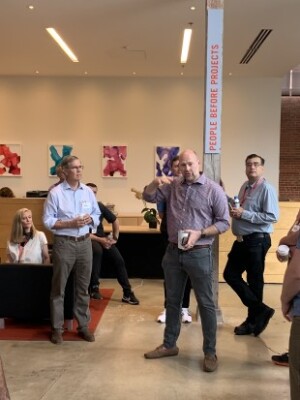
The Elephant room at Hotel Emma in San Antonio’s Pearl District served as home base for presentations, panels and the signature celebration and pechakucha. The room is part of the adaptive reuse of the Pearl Brewery and the meeting space features repurposed tanks as part of the roomʻs defining character. (Jim Heid/CRAFT Development)
In late May, the Small-Scale Developer Forum (SSDF)—the flagship event of what is known as [the] Initiative to Make Small Big—celebrated in San Antonio its 10th year of convening. The SSDF was founded in 2012 as new ULI offering to bring together entrepreneurial real estate developers working at an incremental, neighborhood scale. Born of a desire to reach an audience that was feeling disconnected from ULI due to the scale of some of the larger annual conferences, the initial program attracted 20 attendees for a one-day event in San Francisco. Fast forward ten years and SSDF now brings together over 80 attendees and speakers from all over the country—many returning time and again as the forum fills a void for real estate entrepreneurs focused on “doing development different.”
SSDF 17 was hosted at Hotel Emma in the Pearl District, the ULI Global award winning adaptive reuse project that breaks all the rules of conventional real estate wisdom, while clearly manifesting a set of values and ethos directly aligned with Small.

The three-day program kicked off with a welcome reception cruising San Antonio’s famous River Walk on barges. Reception sponsor and local Small developer Ed Cross offered historic and real estate related insights for San Antonio, as attendees cruised with signature margaritas and wine. (Jim Heid/CRAFT Development)
As with all SSDFʻs, the first day opened immersing attendees in the history and context of San Antonio by Kathryn OʻRourke, art history professor at Trinity University, and Irby Hightower, a principal with Alamo Architects.
This was followed by Pearl BUILD CEO Bill Shown and director of development Omar Gonzales, who shared the vision, thinking, and lessons of Pearl. The alignment of values between Small and Pearl were quickly evident. Take a long-term view. Focus on experience and place to create value. Seek great design and beauty. Don’t follow conventional wisdom. The talk set the stage for detailed walking tours with five members of the Pearl team, so attendees could have an intimate conversation and get detailed answers to their questions as they toured the fine grained, high quality public realm and adaptive reuse of the 27-acre (10.9 hectare) Pearl site.

Tours provide the opportunity for intimate Q+A with the development team. Standing in the lobby of Hotel Emma, Natalie Smith, director of property management for Pearl, discusses how percentage rent structures help attract and curate a unique, local, one-of a-kind tenant mix. (Jim Heid/CRAFT Development)
After a networking lunch at Botika, the group discussed the mechanics of creative leasing. How to find and attract unique tenants; how to select brokers that ‘get it’; and the good, the bad and the ugly of percentage rent deals. Consistent with SSDF open-source approach, the panel grew out of the last Forum, where several long-standing members inquired to their cohorts how to structure a percent rent deal.
The three panelists included two SSDF alumni—Lorenzo Perez of Venue Projects, and Liz Dunn of Dunn & Hobbes. Rounding out the panel was Natalie Smith, Director of Property Management for Pearl Real Estate, who shared experiences and lessons Pearl has learned in creating their unique tenant base that adds to the authenticity of place. Some of the key techniques that Pearl has used with emerging tenants and could be adapted by small developers—making sure your prospects “get your vision” (communicated with a written brief or deck) and requiring a clear business plan–including a social media strategy–from prospects to ensure they have a business acumen to succeed. How to structure rent? Preference was for natural not artificial breakpoints. Be very, very clear on definitions and metrics. Collect data, and then percent rents monthly at best—quarterly at worst to avoid year end surprises that small tenants cannot sustain.
The afternoon wrapped up with an intimate conversation with David Lake, founder of widely acclaimed architectural firm Lake|Flato. The fireside chat led by Ed Cross of San Antonio Commercial Advisors, explored their 40 year relationship—two San Antonio real estate entrepreneurs, whose small deals have helped positively shaped emerging neighborhoods in San Antonio. My notes? Great design matters—but does not have to cost more. The importance of picking partners and structuring that partnership in a way where everyone’s talents are additive. And the most refreshing—the importance of finding partners with whom you can have funand build a long-term friendship with while doing deals that make a difference.
The first full day concluded with SSDF’s signature ‘Small Pechakucha’. Accompanying a networking cocktail hour, Small Pechakucha gives each attendee an opportunity to share a project they are doing, a value they hold or trend they are watching. But with only 3 slides and 14 seconds for each slide—it is a fast paced 40-minute showcase of passion and creativity while connecting individuals with shared interests.

John Byrd and Madison Smith of Overland Partner’s share their firm’s vision and principles for sustainable design. Along with Developer David Adelman of AREA Real Estate, attendees benefited from a deep dive case study of the lessons learned converting a 27,000 plumbing warehouse into Overland’s COTE award winning office space. (Jim Heid/CRAFT Development)
A fabulous dinner celebrating a decade of SSDF gave a shout out the 30-plus attendees who have attended five or more fora), while introducing some of the exciting new programs emerging from [the] Initiative to Make Small Big.
Day 2 took the group off campus into several emerging neighborhoods of San Antonio. First up was stroll along the River Walk to arrive at 203 East Jones, a case study on the adaptive reuse of a plumbing warehouse that now serves as the home of award-winning design firm Overland Partners. The case study, presented by developer David Adelman, AREA Real Estate along with designer, tenant and partner Overland is a 2010 AIA Cote Award winner. Madison Smith and John Byrd talked about some of the key sustainability features and the firm’s commitment to ongoing monitoring of actual performance, while David talked about the tension of making the project feasible while creating something special out of the 27,000 square foot (2,109 sq m) brick warehouse.
Next up the group toured another adaptive reuse: 500 Sixth, a 5,500 square foot (550 sq m) coworking space developed and operated by the husband and wife duo Kristin and Clay Hefty. While a simple building in its raw form, Kristin’s early architectural years at Lake | Flato shown through in the beautifully simple detailing and signature moves that made the space inspired, livable, and flexible. My more memorable ‘small’ moves were the elegant staircase open wall detail that helped define space without cutting off light or views, and the coffee truck parked on the lot’s rear driveway. The permanently parked truck (leased to a separate operator) provides the coworking space ‘accessible espresso’, while creating an amenity for the neighborhood, without the initial fit out and ongoing operating cost to the Heftyʻs.
Next stop was Gerrardo Ituarte’s commitment to the eastside neighborhood, demonstrated through four projects. All built as affordable, missing middle products in this heavily disinvested neighborhood. Acting as developer, designer and contractor, Gerrardo and his wife bring local artists into each of their projects, helping to realize the city’s designation of the neighborhood as an Art District.
Another networking lunch at Box Street provided more time for group conversation followed by a presentation from Andres Andrujar, CEO about the Hemisfair PARC efforts to re-establish a finer grained street system in the 90-acre (36.4 hectare) remnant of the 1968 World’s Fair. Combining public spaces and civic event facilities with small scale interventions to re-establish a street grid and pedestrian environment. Creative public land ownership leasing deals, with local developers to bring new housing and food & beverage, is helping to activate the site.
The final tour of the day was Ben Bowman’s exquisitely executed Boston Commons – a contemporary twist on the cottage court. Cleverly using the site’s topography, Ben and his architect Cotton Estes, created a central mews to organize a series of simple, but beautifully proportioned and detailed small buildings. A mixed program of single-family homes and stacked duplexes flank the central mews. To protect long term value and create a visual terminus for the linear mews, Ben introduced a brilliant two structure, two level compound with six individual bedrooms and ensuite baths, organized around a shared kitchen and living room. Acknowledging there was still a lot to learn, Ben leaned forward into the co-living experiment as a way to bring attainable housing to the neighborhood and improve the project’s economics.
The day ended at Alamo Beer Company where founder Eugene Simor shared his story of building a business and brewery, surviving neighborhood opposition as well as Covid-19. As the group sipped the fruits of his passion, a closing discussion called Help! Desk, gave attendees the opportunity to raise questions and problems they were facing in their own deals, drawing on the wisdom, experience and lessons of others. Topics included securing rental space before it is needed to protect future optionality of the adjoining business, creating lease-to-own housing units as a business model to help build household wealth in moderate income households, and integrating solar and micogrids into small projects.
New this year is the Michael Lander Emerging Developer Scholarship. Michael Lander, a long-time small developer from Minneapolis and ULI member, has underwritten one registration for a local emerging developer to attend the Forum as a way to gain new experience and contacts. This concept resonated deeply with attendees, who recognize Small is a gateway to DEI.
Next year the program will be expanded to create scholarships for both local emerging developers and public officials or civic leaders who would benefit from hearing the conversation in the room, and gaining greater insight into how to bring Small to their community.
Want More Small?
Here are some ways to learn more about Small and take advantage of ULI’s collaboration with [the] Initiative to Make Small Big
- Small Scale Developer Forums – Registration for SSDF#18 is now open. Scholarships are available for first-time attendees including DEI, recent graduates and civic leaders. Register here.
- TEDx talks Building Small – watch the presentation by author Jim Heid here.
- Learn more about [the] Initiative to Make Small Big here
- Watch for a half-day professional development program on Building Small at the ULI Fall Meeting 10/24.
Jim Heid, FASLA, is the author of Building Small and Founder of the Small Scale Developer Forum. Trained as a landscape architect he is now an infill developer and proponent of small scale, incremental development working across the U.S. An active ULI member for over 30 years, you can learn more about Jim and his Small efforts at www.jheid.com.







